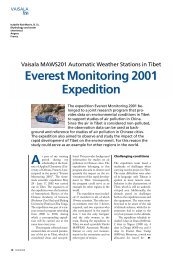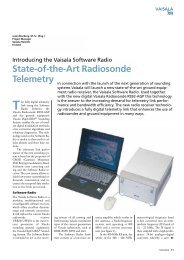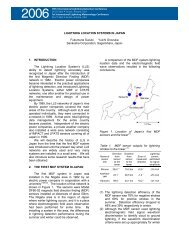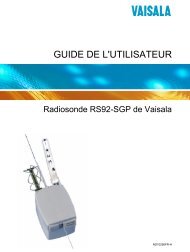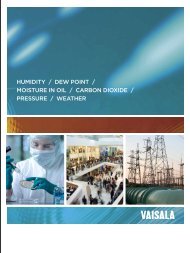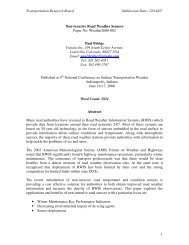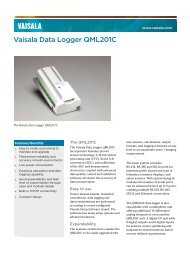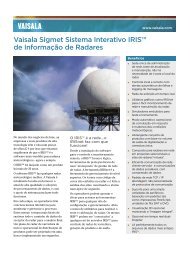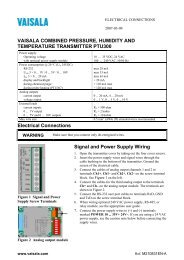Vaisala News 180 - Full Magazine
Vaisala News 180 - Full Magazine
Vaisala News 180 - Full Magazine
Create successful ePaper yourself
Turn your PDF publications into a flip-book with our unique Google optimized e-Paper software.
Group to promote global awareness<br />
about the phenomenon.<br />
Challenge to pilots<br />
and aircraft safety<br />
Microbursts and wind shear go<br />
hand in hand. Microbursts are small<br />
scale intense downdrafts which, on<br />
reaching the surface, spread outward<br />
in all directions from the downdraft<br />
center. This causes the presence of<br />
both vertical and horizontal wind<br />
shears. Microbursts spread radially<br />
on the ground, causing rapid changes<br />
in wind direction and speed. They<br />
are associated with cumulonimbus<br />
clouds, as well as line squalls (severe<br />
thunderstorms). A distinction can<br />
be made between a wet microburst<br />
which consists of precipitation and<br />
a dry microburst which consists<br />
of virga - that is, precipitation that<br />
evaporates before reaching the<br />
ground. Dry microbursts present a<br />
more difficult problem because pilots<br />
have no visual clue of their occurrence,<br />
and weather radars cannot see<br />
them either.<br />
Wind shear and microbursts are<br />
among the most dangerous of all<br />
weather-related threats to flying. The<br />
unpredictable changes in wind speed<br />
and direction make it difficult to<br />
control the aircraft, with headwinds,<br />
tailwinds and up and down drafts<br />
all in quick succession. At worst, it<br />
can cause a sudden and dramatic<br />
loss in height, and result in a serious<br />
accident.<br />
Downdraft<br />
How to address wind<br />
shear safety risks?<br />
When wind shear occurs below 2,000<br />
ft altitude, it is called low-level wind<br />
shear. Many airports prone to microburst<br />
and wind shear are still lacking<br />
adequate solutions to mitigate this<br />
threat.<br />
The first step in addressing safety<br />
hazards caused by wind shear is<br />
to investigate the likelihood of the<br />
occurrence of the phenomenon at<br />
the airport in question. If a problem<br />
is recognized, different options for<br />
solving it need to be investigated in<br />
order to find the optimal solution.<br />
Each airport is unique. This work<br />
is best carried out in cooperation<br />
with the airport authorities and an<br />
expert organization with deep understanding<br />
of the phenomenon.<br />
Once the existence of low-level<br />
wind shear has been verified through<br />
studying the weather conditions at<br />
the airport, the next step is to specify<br />
the optimal wind measurement site<br />
locations and measurement mast<br />
heights by studying the topology and<br />
obstructions in the area. After this,<br />
the required system and interfaces<br />
can be specified by investigating the<br />
existing infrastructure.<br />
A Low-Level Wind Shear Alert<br />
System (LLWAS) comprises wind<br />
speed and direction sensors sited<br />
around the runway, and connected to<br />
a data collection package at the site.<br />
Wind shear alerts are presented both<br />
visually and audibly, and the affected<br />
While the pilot compensates<br />
for the headwind by dipping<br />
the nose, the aircraft enters a<br />
A headwind slows and<br />
downdraft.<br />
lifts the aircraft above<br />
its normal flight path. A tailwind dangerously<br />
reduces the aircraft’s<br />
speed.<br />
The glide path of a normal landing.<br />
areas can be easily identified thanks<br />
to the system. Access to wind shear<br />
data eases the air traffic controller’s<br />
burden, increases the pilots’ confidence<br />
at a particular airport, and<br />
improves the overall aviation safety.<br />
All required services should also<br />
be mapped in close cooperation with<br />
the airport authorities, in order to<br />
ensure the optimal performance of<br />
the system throughout its lifecycle.<br />
Planning ahead pays dividends in the<br />
long run, as system maintenance and<br />
operations become proactive and<br />
organized, and the need for ad-hoc<br />
fixes is reduced. Good data availability<br />
can be maximized through<br />
various well-planned services, such<br />
as preventive maintenance, software<br />
upgrades, and regular solution<br />
performance verifications.<br />
All the studies and investigations<br />
materialize in an implementation<br />
project plan. Once the low-level wind<br />
shear system has been installed, it<br />
is carefully tested to ensure that it<br />
meets all the requirements. Professional<br />
user-training as well as periodical<br />
training updates are an important<br />
part of the project. Tailored lifecycle<br />
services, designed before system<br />
implementation and according to<br />
the specific requirements, support<br />
smooth and safe operations. A professionally<br />
run wind shear project is a<br />
huge improvement in airport safety.<br />
If you would like to discuss the<br />
implications of wind shear for airport<br />
operations and aviation safety, please<br />
contact aviationsales@vaisala.com.<br />
Further information:<br />
www.vaisala.com/weather/<br />
products/avi-llwas<br />
References:<br />
Fujita, T.T.; The Downburst,<br />
microburst and macroburst<br />
FAA; Advisory Circular Pilot<br />
Wind Shear Guide<br />
Guan, Wen-Lin & Yong Kay;<br />
Review of Aviation Accidents<br />
Caused by Wind Shear and<br />
Identification Methods<br />
Juhani Polvinen; Wind shear:<br />
predicting the unpredictable<br />
<strong>180</strong>/2009 5




